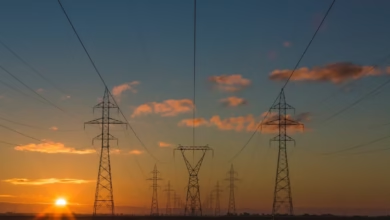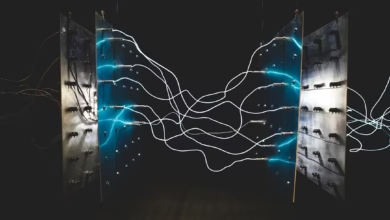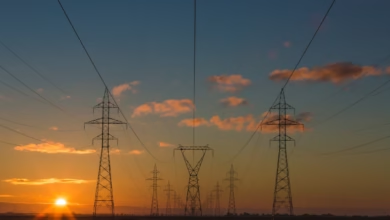Smart Grids: Transforming Energy Efficiency and Security in the Renewable Energy Transition

In an era marked by urgent calls for sustainable practices and a decisive shift away from fossil fuels, the modernization of electricity grids through smart technology stands at the forefront of the energy transition. Smart grids not only enhance energy efficiency but also bolster energy security, providing a robust platform for integrating various renewable energy sources such as solar power, wind energy, and hydropower. As global energy trends evolve, the need for innovative solutions becomes increasingly critical to manage the complexities of energy markets and policy frameworks. This article will explore how smart grids are revolutionizing the energy landscape, driving the integration of renewables, and paving the way for advancements in energy storage and transportation. With a focus on innovations in energy R&D and their role in combating climate change, we will delve into the transformative potential of smart grids in creating a greener, more resilient energy future. From the adoption of electric vehicles to the implementation of carbon capture technologies, the journey towards a sustainable energy economy is intricately linked to the evolution of smart grid systems. Join us as we uncover how these technologies are not just reshaping energy consumption but are also setting the stage for a comprehensive energy transition.
- 1. How Smart Grids are Driving the Energy Transition: Enhancing Energy Efficiency and Security
- 2. The Role of Smart Grids in Integrating Renewable Energy Sources: A Pathway to Sustainable Energy Markets
1. How Smart Grids are Driving the Energy Transition: Enhancing Energy Efficiency and Security
The transition to smart grids is a pivotal element in modernizing electricity systems and addressing the pressing challenges of climate change and energy security. Smart grids integrate advanced technology to enhance energy efficiency, facilitate the adoption of renewable energy sources, and improve overall energy management. This transformation is crucial as it supports the shift from fossil fuels and nuclear energy towards greener alternatives, such as solar power, wind energy, and hydropower.
By leveraging real-time data and communication technologies, smart grids optimize energy distribution and consumption patterns, allowing for more effective integration of distributed energy resources. This capability is vital in managing the variability of renewable energy sources while ensuring a reliable power supply. With enhanced energy storage solutions, such as batteries and hydrogen energy systems, smart grids can store excess energy generated during peak production times and release it when demand is high, thereby improving energy efficiency.
Moreover, smart grids bolster energy security by minimizing interruptions and enhancing the resilience of energy infrastructure against potential threats. This is increasingly important as global energy trends indicate a rising reliance on renewable energy and the need for robust energy policy frameworks that support energy investment and innovation. Furthermore, smart grids aid in the development of energy markets, enabling greater participation from consumers and facilitating the trading of energy exports and imports, thus creating a more dynamic and competitive energy landscape.
As energy R&D continues to advance, the integration of smart grids with electric vehicles and carbon capture technologies will further drive the energy transition. By promoting energy innovations and investments in green energy, smart grids not only enhance energy efficiency but also contribute significantly to the reduction of carbon emissions. In summary, the modernization of electricity grids through smart technology is critical for fostering a sustainable energy future, ensuring energy security, and achieving the ambitious goals of the global energy transition.
The modernization of electricity grids through smart technology, often referred to as smart grids, represents a significant leap forward in energy management. By integrating advanced communication and automation technologies, smart grids enhance the efficiency, reliability, and sustainability of electricity distribution. This transformation is critical as the world moves towards an energy transition that prioritizes renewable energy sources such as solar power, wind energy, and hydropower while reducing reliance on fossil fuels and nuclear energy.
One of the primary benefits of smart grids is their ability to improve energy efficiency. With real-time data analytics, energy providers can optimize energy transportation and reduce waste, leading to lower operational costs and enhanced energy security. Moreover, smart grids facilitate the integration of distributed energy resources, including bioenergy and thermal energy, which are essential for creating a diverse energy mix that supports climate change mitigation efforts.
Energy storage technologies also play a crucial role in this modernization. By effectively harnessing excess energy generated from renewable sources, smart grids can stabilize energy markets and provide a reliable supply even when generation fluctuates. This capability is particularly vital as the demand for electric vehicles rises, necessitating robust energy infrastructure to support charging and consumption patterns.
The ongoing evolution of energy policy and investment in energy R&D is shaping global energy trends. Governments and private sectors are increasingly focused on innovations such as carbon capture and hydrogen energy to transition towards greener energy solutions. Offshore energy developments are also gaining traction, providing new avenues for energy exports and contributing to a more resilient energy economy.
Ultimately, the integration of smart grids paves the way for a more sustainable future. By embracing energy innovations and adapting to changing energy demands, societies can effectively address the challenges posed by climate change, enhance energy security, and optimize energy economics for the benefit of all. As we advance, the collaboration between energy markets, policymakers, and technology developers will be essential in realizing the full potential of smart grids in the global energy landscape.
2. The Role of Smart Grids in Integrating Renewable Energy Sources: A Pathway to Sustainable Energy Markets
The modern energy landscape is undergoing a significant transformation, driven largely by the integration of smart grids. Smart grids play a pivotal role in facilitating the incorporation of renewable energy sources into the existing energy markets, paving the way for a more sustainable energy future. By leveraging advanced technologies, these grids enhance energy efficiency and improve energy security, making it possible to manage the variable nature of renewable energy sources such as solar power and wind energy.
One of the key advantages of smart grids is their ability to support distributed energy generation. As more individuals and businesses invest in green energy solutions, including solar panels and wind turbines, smart grids enable efficient energy transportation from these decentralized sources. This transition not only reduces dependence on fossil fuels but also fosters energy independence by promoting local energy generation.
Furthermore, smart grids enhance energy storage capabilities, which are essential for optimizing the use of renewable energy. Energy storage technologies, such as batteries, allow excess energy generated during peak production times to be stored and used later, ensuring a steady supply even when renewable sources are not actively generating electricity. This capability is crucial for integrating intermittent resources like solar and wind energy into the grid, ultimately supporting a more stable energy market.
In addition to improving energy storage, smart grids facilitate the deployment of electric vehicles (EVs), which are becoming a vital component of the energy transition. By enabling vehicle-to-grid technologies, smart grids allow EVs to serve as mobile energy storage units, providing additional flexibility to the energy system. This innovation not only supports renewable energy integration but also helps reduce carbon emissions associated with traditional fossil fuel-based transportation.
Moreover, as global energy trends shift towards a decarbonized future, smart grids can enhance energy policy and guide energy investments in sustainable technologies. By providing real-time data on energy consumption and generation, these grids empower policymakers to make informed decisions that align with climate change goals and energy economics. This includes promoting investments in energy R&D and innovations aimed at further improving energy efficiency and reducing reliance on thermal energy and nuclear energy.
In conclusion, the role of smart grids in integrating renewable energy sources is crucial for achieving a sustainable energy market. By enhancing energy efficiency, enabling energy storage, and facilitating the deployment of electric vehicles, smart grids act as a catalyst for the energy transition. As we continue to navigate the complexities of energy imports and exports, the importance of smart grids in shaping a resilient, low-carbon energy future cannot be overstated.
In conclusion, the advent of smart grids represents a significant leap forward in modernizing our electricity infrastructure, crucial for achieving a successful energy transition. By enhancing energy efficiency and security, smart grids are paving the way for the integration of renewable energy sources, including solar power, wind energy, and hydropower. This integration not only supports the shift away from fossil fuels and nuclear energy but also fosters a more resilient and sustainable energy market capable of meeting the challenges posed by climate change.
Moreover, as we navigate global energy trends, the role of smart grids in energy storage and distributed energy systems becomes increasingly vital. They facilitate the seamless transportation of energy, enabling the effective utilization of green energy sources and ensuring that energy investments align with contemporary energy policy. With innovations in energy R&D, such as carbon capture and hydrogen energy, smart grids are at the forefront of driving energy economics that prioritize sustainability and energy security.
As we look to the future, it is clear that smart grids will be essential in not only enhancing energy efficiency but also in shaping the landscape of energy markets globally. By embracing these technologies, we can foster a robust energy infrastructure that supports electric vehicles, expands energy exports, and reduces reliance on energy imports, ultimately contributing to a cleaner, greener planet. The transition towards smart grids is not just a technological upgrade; it is a strategic move toward a sustainable energy future, underscoring the importance of continued investment and innovation in this vital sector.





